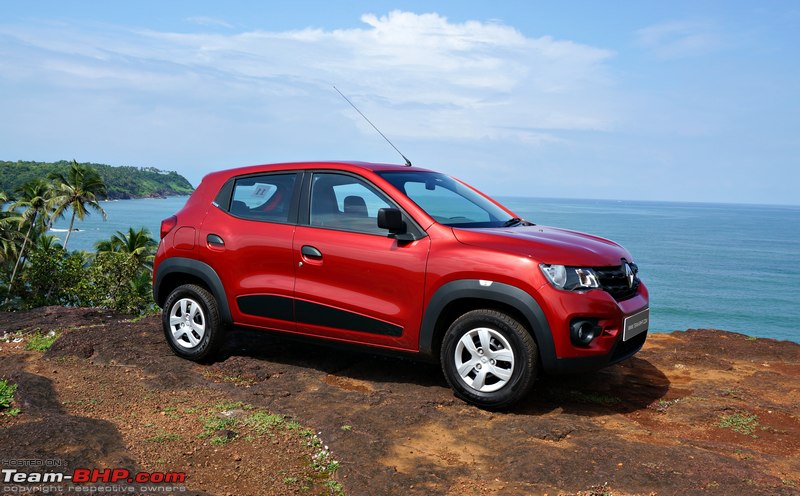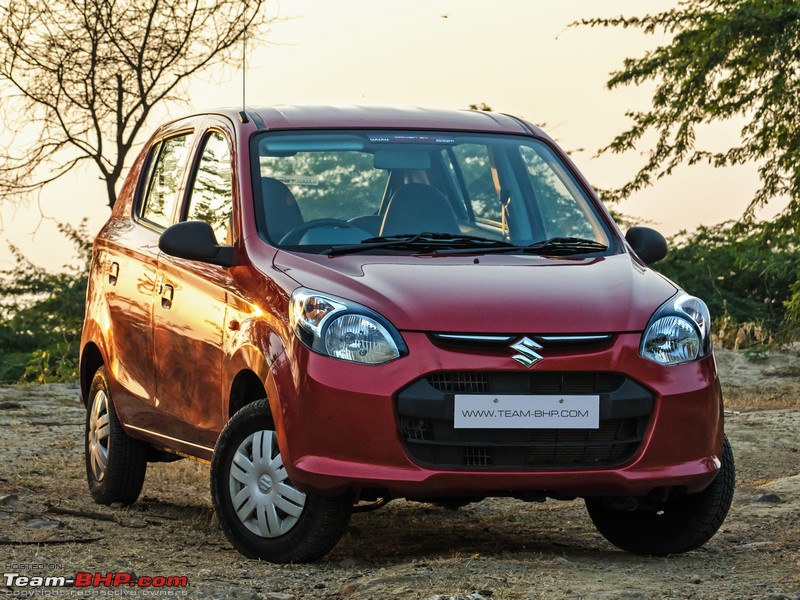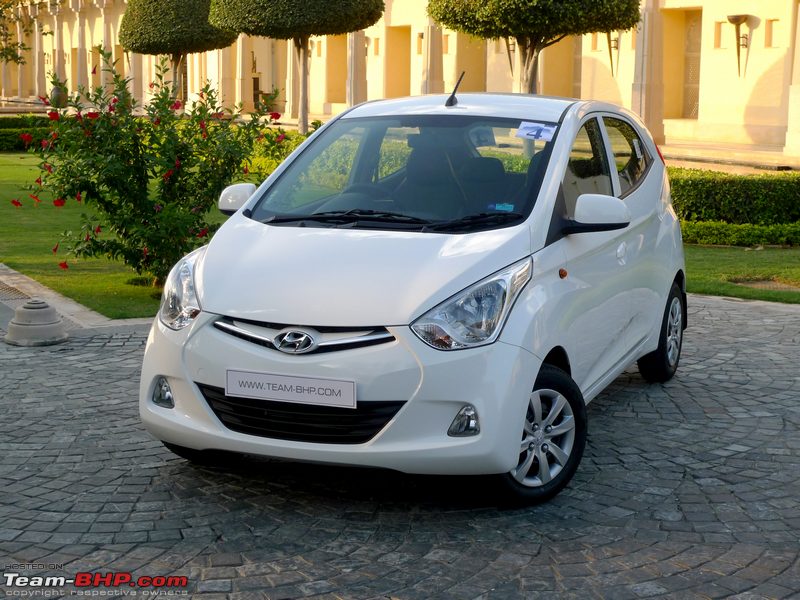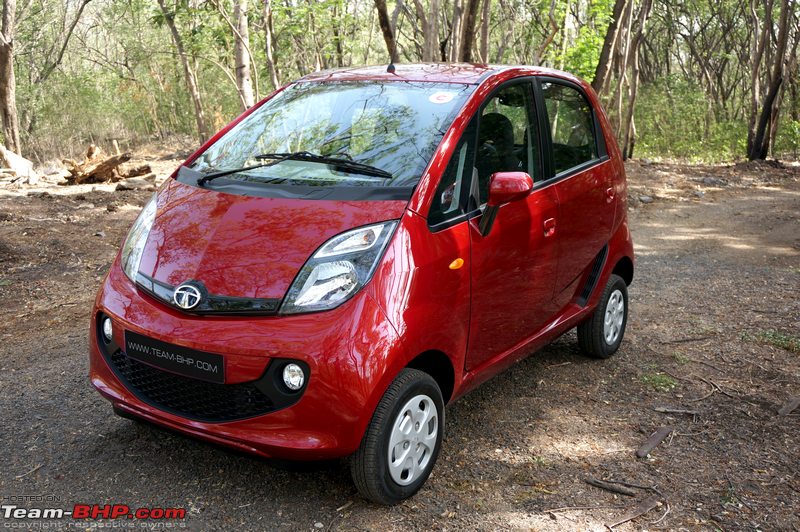| |||||||
| Search Forums |
| Advanced Search |
| Go to Page... |
 |
| Search this Thread |  1,347,396 views |
| | #1 |
| Team-BHP Support  | Renault Kwid : Official Review The Renault Kwid has been launched in India at a price of between Rs. 2.57 - 3.53 lakhs (ex-Delhi). What you'll like: • Distinctive styling! Looks swell for an A-segment hatchback • Value-for-money pricing. A lot of car for the money • Well-packaged cabin with good space, comfy seats & lots of storage • Huge 300 liter boot. 2nd biggest among all hatchbacks! • 799 cc petrol has sufficient pep for the city. ARAI fuel efficiency rating is the highest for any petrol car • Suspension offers a comfortable ride with neutral handling. 180 mm of ground clearance too • Equipment in a budget car (driver's airbag, digital meter cluster, touchscreen ICE, navigation, full MID & more) What you won't: • 3-cylinder engine causes vibrations (especially when idling) & sounds unpleasant (as the revvs climb) • Some essential features missing (internally adjustable ORVMs, retractable rear seatbelts etc.) • Mediocre expressway competence. Best driven <100 km/h • Renault's dealer & after-sales network is far weaker than that of Maruti or Hyundai • 28 liter fuel tank is the smallest in the segment and its 5 meter turning radius the biggest The 1.0L Engine: • Link to review The Automatic: • Link to review Last edited by GTO : 30th November 2016 at 17:26. Reason: Link to AMT review :) |
| |  (75)
Thanks (75)
Thanks
 |
| The following 75 BHPians Thank Vid6639 for this useful post: | .anshuman, achyu, aeroamit, Aficionados, anilntny, Aragorn, aravindkumarp, asingh1977, BaluJ, Carpainter, carrazy, Chethan B G, deetjohn, DetonatoR, Doge, Full_Minchingu, fusionbang, Fx14, gearedup, Grand Drive, GTO, iliketurtles, Interstellar, Jaggu, joe_antony, john doe, johnruben, JoseVijay, kannan666, Karthik Chandra, low_range, mh09ad5578, mi2n, Mighty_Lothar, moralfibre, Mr.Hunt, mrbaddy, mvadg, Nagato710, noopster, NPV, petrolhead_neel, Rajeevraj, RavenAvi, ravradha, rev_rohit, rshanker, RSR, S.MJet, S2!!!, samabhi, SandyX, scopriobharath, SDP, sdp1975, Simhi, skotha, SmartCat, sourav9385, Stratos, suhaas307, swiftnfurious, Thad E Ginathom, theexperthand, turbospooler, Tushar, uday.ere, valapad, vb-saan, vibbs, VijayAnand1, vikred, vishy76, wadewilson, Wildy |
| |
| | #2 |
| Team-BHP Support  |  Renault started its second innings in India in 2011 with the Fluence, a premium D-segment sedan, with an aim to build an image for itself. The premium crossover Koleos followed in 2012. Both these cars were market duds, yet these were the initial steps for Renault to build a dealer network in India and spread awareness about the brand (unlike sister concern Nissan which outsourced the entire dealer network). The launch of the Duster did the rest. It created a new crossover segment in India. Until March 2015, the Duster was a consistent 3,000 sales / month performer, although its numbers have declined, going into a yo-yo since April 2015 (the Lodgy's production started in the same month). With the dismal performance of the Scala & Pulse, and even the practical Lodgy failing to make a statement in the market, the Kwid is key to the brand's growth aspirations. That does explain the aggressive pricing. The Duster has built itself a lot of goodwill in the market. There's no doubt this will help Renault with the Kwid. Renault - as a brand - isn't unknown like it was before the Duster's launch. The company is eyeing a 5% market share by 2017. What better category to increase volumes than the mass market A-segment which delivers ~30,000 cars each month? The biggest challenge in the Indian car market is to succeed in the entry level A-segment which Maruti has been dominating since decades. We Indians love affordable cars, but not necessarily cheap cars. Just ask Tata who learnt this lesson the hard way with the Nano. More than price, buyers seek value in what they purchase. Nobody knows the pulse of the Indian car buyer better than Maruti, who consistently churns out ~22,000 copies of the Alto every month. Hyundai has been able to secure a distant second spot in this segment with the Eon, selling ~6,000 units every month. Renault decided to go against the two big daddies - Maruti and Hyundai. They concentrated on the 3 important aspects which we love in our cars - styling, space and affordability. The result of this is what you see here, the Renault Kwid. At the 2014 Auto Expo, Renault unveiled a crazy concept car with the same name (link). The Kwid concept looked like a funky compact SUV with Lamborghini-style scissor doors, crazy offroad tyres, twin spring suspension and spaceship-styled interiors. This was possibly the first clue on what to expect from Renault. They finally unveiled the production version of the Kwid in May 2015 at Chennai, with head honcho Carlos Ghosn personally taking the wraps off it. It is the first car to be unveiled outside Europe by the French manufacturer. Initially, the Kwid will be sold only in India, after which it will move to South America and other emerging markets. Yes, it’s been designed from the ground up with India as its primary market. Korea, France, Japan and India have played a crucial role in its development, while the Renault India design centre had a huge hand in giving shape to this car. The Kwid is the brainchild of Gérard Detourbet who is also the man behind the Logan, Duster and Lodgy. Gérard mentioned that, until recently, Renault brought in European cars to India and tuned them for our roads and driving conditions. With the Kwid, Renault has designed every aspect of the car for India. The Kwid concept that was displayed at the 2014 Auto Expo: 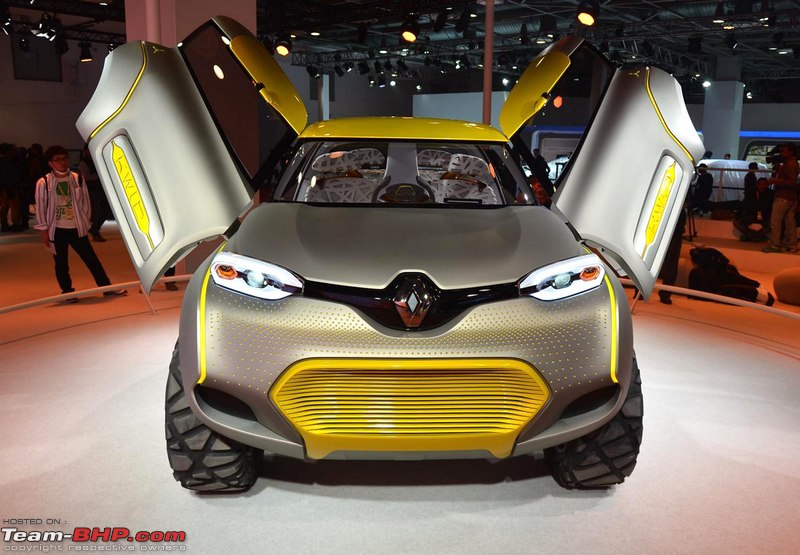 The Kwid is the first car based on Renault’s new CMF-A platform. CMF-A is the entry level category in the CMF or Common Module Family architecture (similar to VW’s MQB platform). The CMF aims to modularize different sections of the car (cockpit, engine bay, electrical architecture, front underbody and rear underbody) which can be shared across multiple cars, thereby standardizing the manufacturing process and significantly reducing production & procurement costs. Currently, there are three categories under the CMF architecture, the CMF-A, CMF-B and the CMF-C/D. The CMF-B is also for compact cars, but there are no vehicles based on it as of now (learn more), while the CMF-C/D has the Nissan Qashqai, Kadjar, X-Trail, Rogue and Espace. The key challenge in competing with the likes of Maruti / Hyundai is to keep costs down, thus maximizing localization is compulsory. Renault has worked with local vendors relentlessly to control costs and the Kwid has 98% localization right from day one itself. The remaining 2% is mostly for critical sensors which are still imported. Renault boasts of being the only non-Indian manufacturer to achieve this level of localization on a new vehicle at the time of launch. The company had hinted at an aggressive price of Rs. 3-4 lakhs when the car was unveiled. This was closer to the Eon’s pricing than the Alto 800’s. Renault did not K(w)id around (sorry, but I had to use this pun at least once  ) and actually gave a very pleasant surprise to everyone. The base model starts at Rs. 2.57 lakhs which is within Rs. 1,000 of the base Alto 800 Std. variant! This is the entry-level version, devoid of any features like A/C & power steering. The model to get is quite clearly the top spec RXT with an airbag at Rs. 3.53 lakhs ex-showroom. This variant costs merely Rs. 6,000 more than the Alto 800 VXI with airbags and offers a lot more bang for the buck. You get a 7” touchscreen head-unit with sat-nav, remote locking, a very comprehensive MID and - more importantly - a bigger & more spacious car. The Eon 800cc top spec at Rs. 4.13 lakhs is priced very far away. Renault have literally shaken up the entry-level segment with this pricing! Maruti and Hyundai are wondering how Renault managed to pull off this pricing. Of course, the French company's road ahead isn’t going to be easy, as they don’t command the same reputation as that of Maruti and Hyundai. Its sales & support network isn’t anywhere close to the 2 market leaders either. That said, the first job of getting the prices bang on has definitely been achieved. The Kwid got 25,000 bookings in the first two weeks of launch and, interestingly, 40% of its customers are below 28 years of age (source). They now need to ensure that their manufacturing plant and dealer network are up to the task. ) and actually gave a very pleasant surprise to everyone. The base model starts at Rs. 2.57 lakhs which is within Rs. 1,000 of the base Alto 800 Std. variant! This is the entry-level version, devoid of any features like A/C & power steering. The model to get is quite clearly the top spec RXT with an airbag at Rs. 3.53 lakhs ex-showroom. This variant costs merely Rs. 6,000 more than the Alto 800 VXI with airbags and offers a lot more bang for the buck. You get a 7” touchscreen head-unit with sat-nav, remote locking, a very comprehensive MID and - more importantly - a bigger & more spacious car. The Eon 800cc top spec at Rs. 4.13 lakhs is priced very far away. Renault have literally shaken up the entry-level segment with this pricing! Maruti and Hyundai are wondering how Renault managed to pull off this pricing. Of course, the French company's road ahead isn’t going to be easy, as they don’t command the same reputation as that of Maruti and Hyundai. Its sales & support network isn’t anywhere close to the 2 market leaders either. That said, the first job of getting the prices bang on has definitely been achieved. The Kwid got 25,000 bookings in the first two weeks of launch and, interestingly, 40% of its customers are below 28 years of age (source). They now need to ensure that their manufacturing plant and dealer network are up to the task.  When you see the Kwid for the first time, you are left wondering whether it really is an A-segment contender. Thanks to the SUV design cues, raised stance and significantly larger dimensions, the Kwid looks more like a hatchback-turned-crossover like the Etios Cross or i20 Active. At 3,679 mm, it’s actually longer than the Alto 800 (3,395 mm), Eon (3,495 mm) and even the Celerio (3,600 mm)! The Kwid is wider than its immediate rivals too at 1,579 mm and overall, the Renault looks much larger in appearance. The SUV stance with the raised ground clearance and beefed up wheel arches make it feel like a tall vehicle which it actually isn’t! Fact is, it’s only 3 mm taller than the Alto 800 and 22 mm shorter than the Eon. What also helps is the bonnet which isn't as steeply raked. The square-ish front gives it a muscular look belying the actual dimensions. The Kwid gets black cladding on the wheel arches as well as both bumpers. The rear bumper is almost entirely black with only the sides being body coloured. Lower trims don’t get body coloured bumpers at all. The side profile has minimal overhangs and the l-o-n-g wheelbase of 2,422 mm is comparable to that of the Grand i10 (62 mm more than the Alto 800). What’s interesting is that the doors appear to have black plastic side cladding similar to the Grand i10, but in reality, it is just a vinyl sticker. The Hyundai Eon proved that entry-level cars can look good. Its fluidic styling made it stand apart and gave it an edge over the dated Alto 800. The Kwid, on the other hand, follows a more European design language. Overall, in terms of styling, it’s safe to say that the Kwid is the best-looking entry level car out there. Period. Given the dimensions of the vehicle, its kerb weight comes as quite a shock. At 660 kilos (top variant), the Kwid is the lightest car on sale in India. Renault says that the Kwid has a power-to-weight ratio of 84 BHP / ton. Run a reverse calculation and we arrive at a 635 kilo kerb weight for the base variant! That makes the Kwid the lightest car on sale in India - the Alto 800 and Nano are 60 kilos heavier!! While we cannot comment on the safety aspect, Renault claims that the car can easily be updated to meet higher safety standards whenever they are enforced in India (meaning, as of date it doesn't meet those standards). They have designed the Kwid keeping this in mind. We don't expect the Kwid to score big stars in an NCAP test, but to be fair, neither do the Alto or Nano. To save weight, the engineers have gone as far as reducing the overall number of screws & bolts, and extensively using plastic components under the hood. Cutting down on screws and bolts shaved nearly 6 kilos in the overall weight. As an example, there are only 3 bolts on each tyre instead of 4 (like the Nano). Having 3 bolts can be considered as a safety hazard and isn't even permitted in some EU countries, although Renault insists that the overall weight & performance don't warrant a 4th bolt. The oil sump is made of plastic instead of metal. Luckily, the 180 mm of ground clearance should reduce risk of damage to the sump. The engine valve cover (not the cylinder head) is made of plastic. We performed a 'tapping' test on the body and found that the doors & other panels felt acceptable; they're surely less tinny in comparison to the Alto 800. No, the doors don’t shut with a solid “thud”, but neither do they feel light & hollow. Even the bonnet is sufficiently heavy for an entry-level hatchback. The only part that felt hollow was the boot lid which is very light. That said, the overall build quality of the Kwid is good. Panel gaps were in check for the most part (only the rear bumper alignment didn't look perfect). It looks like Renault has worked hard on this as we've earlier seen very inconsistent panel alignment in cars like the Datsun Go, Sunny and Micra. 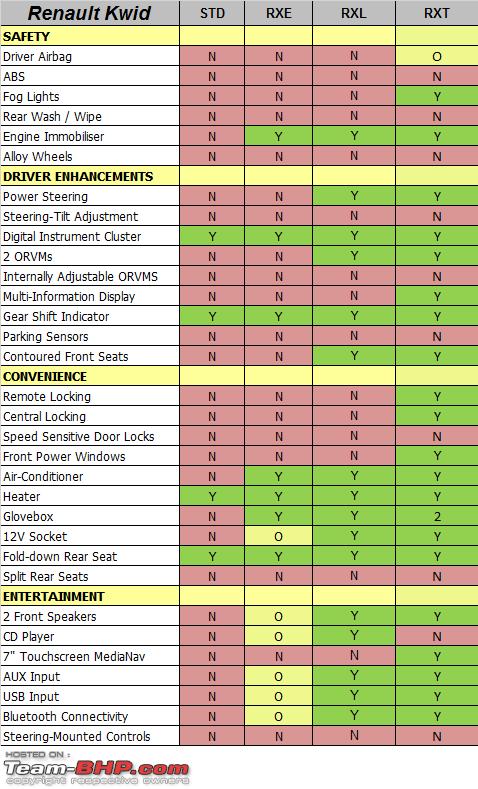 Renault will be selling the Kwid in 4 variants, with the top spec RXT getting an optional driver airbag. ABS is not available on any variant. This is in line with what Maruti offers on the Alto 800. Interestingly, cars exported to Brazil will have dual airbags and ABS! We hope the Indian Kwid gets ABS sooner rather than later. The 2 lower variants STD and RXE don’t get power steering or 2 ORVMs. The STD even loses out on an air-conditioner and a glovebox! The RXL and RXT are the only sensible variants one can consider. Further, the RXT has a USP in this segment - a 7” touchscreen infotainment system with satellite navigation, Bluetooth, USB and AUX-IN. The head-unit is identical to the one available in the Duster and Lodgy. Renault has cleverly designed this hatchback keeping the Indian markets obsession with crossovers / SUVs in mind. Look at it in isolation and the raised stance, black bumper cladding and flat bonnet make it seem very SUV'ish:  I can't help but find an uncanny resemblance to the Grand i10's derrière. Notice that the rear bumper is almost 70% black plastic. Lower variants don't even get that 30% of body colour on the bumper. Sad to see no rear wiper / washer available:  Wheelbase is longer than the Alto's. At 2,422 mm, it's just 3 mm shy of the Grand i10's. The wheels are pushed to the farthest corners of the car:  At a time when hatchbacks are followed by their superficial cross variants, the Kwid has been given the cross treatment at the start itself! Renault calls this an "SUV-inspired design":  A casual glance at this car and it appears to be a lot more expensive than what the price tag indicates:  The market leader and the newest challenger. The Kwid looks a full size larger than the Alto 800:  Alto 800 is 284 mm shorter than the Kwid. These cars compete in a segment where fuel efficiency is critical. While the Alto 800 has an ARAI rating of 22.74 km/l, the Kwid scored 25.17 km/l on the test:  The Renault is 89 mm wider than the Alto 800 and it shows. Surprisingly, the difference in height is only 3 mm in favour of the Kwid. Viewed in isolation, we thought it would be much taller. Kwid's tail-pipe doesn't protrude out like the Alto's:  The Duster and its k(w)id brother:  Notice the C-shaped chrome accent in the housing (on both sides). It's also good to see blackened headlights vs the overdose of chrome we usually see:  Headlamps are housed far behind in a plastic housing. You can see the bumper through the headlamp lens which means you'll see accumulated dirt here with time:  I liked this unique & funky grill. The diamond logo cuts into the bonnet line:  The front grill theme is carried over to the air dam too:  A cool foglamp housing design. Don't miss the exposed tow hook: 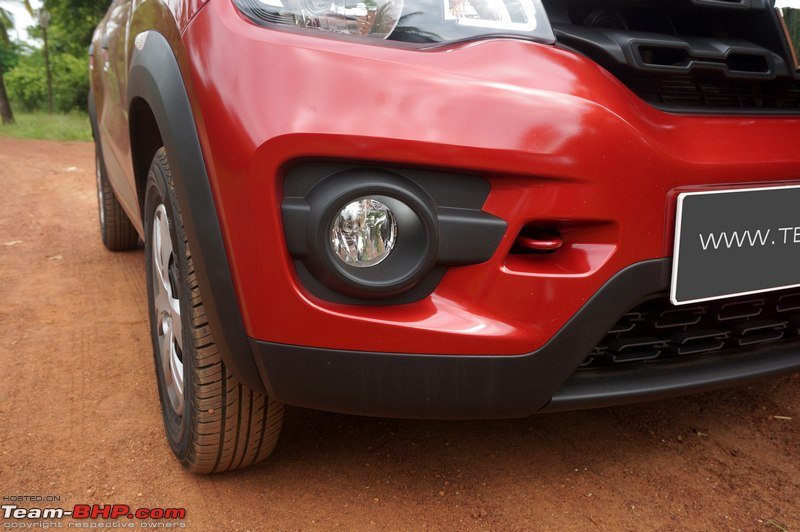 Very aggressive bonnet lines. Kwid has a single windscreen washer which is located on the bonnet:  Cost cutting - A double arm single blade wiper:  While the single wiper is still acceptable, not having any plastic cover near the windshield cowl is an eyesore! You can see bare exposed metal there. It will need regular cleaning of leaves and twigs:  Very stylish - the turn indicators are uniquely integrated in the black wheel well cladding:  155/80 R13 JK Tyres performed competently (we were surprised!). They didn't squeal much and offered respectable amounts of grip too. 3 wheel nuts will raise concerns & suspicion. Renault's argument: why don't cars having 4-wheel nuts get 5? No alloy wheels, all variants get wheel caps:  The biggest downer in this car are the manual ORVMs. A car with a 7" touchscreen navigation system doesn't get proper ORVMs - seriously? Even the Alto 800 has proper ORVMs:  Old school flap-type door handles in black:  The black sure breaks the monotone:  This isn't a plastic cladding though, it's a vinyl sticker! Plastic molding is available as an accessory though:  Black B-pillars and a plastic rear quarter panel. Notice the window line sloping upwards:  Variant name can be found here. The upward slope continues in the body line too:  L-O-N-G roof antenna:  A depressed roof design for better rigidity:  The Kwid doesn't get any rubber strips to conceal weld marks on the roof. Instead, Renault have applied a gel-like substance here which is painted over:  All variants get this integrated roof spoiler:  Huge gap present in the rear wheel well. Don't miss the tiny protrusion on the wheel well cladding:  Boot lid cuts its way around the wraparound tail-lamps:  Kwid badge and Renault logo grab the centre position on the tailgate:  While the windscreen may appear to be big, the viewing area is smaller. This, coupled with its sloping angle, actually reduces the functionality:  Slot in your fingers to lift the light hatch. There's no button inside, you need to unlock it with the key or from the lever on the driver's side: 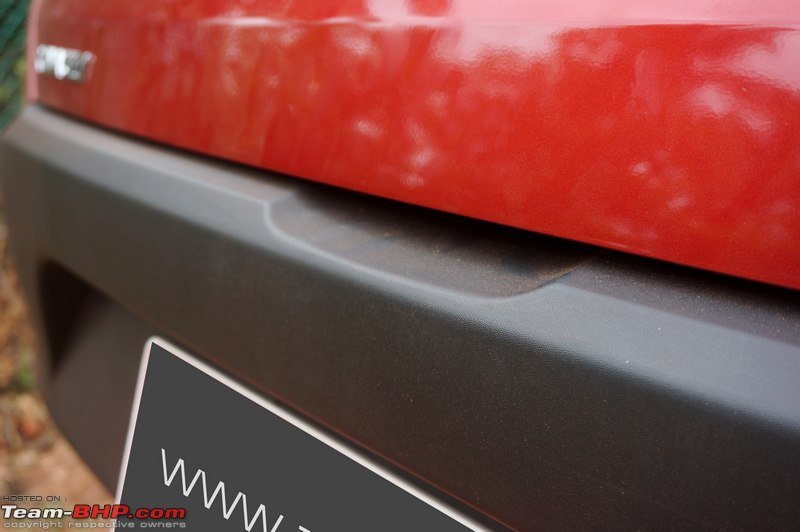 Will the Kwid help the French car manufacturer reach its market share target of 5%? Only time will tell...  Outback Bronze colour from the Duster looks fresh & premium in a car of this segment: 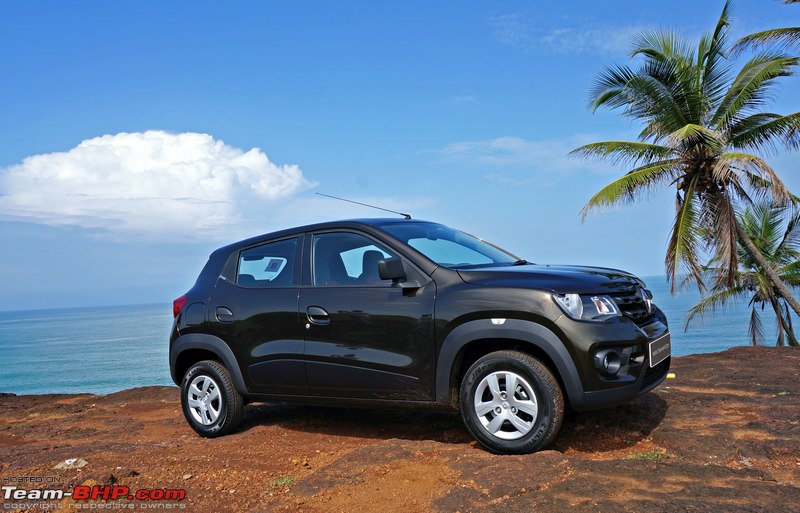 Last edited by GTO : 15th October 2015 at 10:22. |
| |  (61)
Thanks (61)
Thanks
 |
| The following 61 BHPians Thank Vid6639 for this useful post: | .anshuman, achyu, aeroamit, AJ-got-BHP, aravindkumarp, Ashir, ashpalio, asingh1977, beejay, carrazy, Chethan B G, Chrome6Boy, deetjohn, dr. sen, Dr.Naren, Full_Minchingu, fusionbang, gearedup, GTO, InControl, Jaggu, JoseVijay, kannan666, lancer_rit, mh09ad5578, mi2n, mrbaddy, nkghai, noopster, pankaj_sachdeva, peterjim13, petrolhead_neel, Puffdamgcdragon, RavenAvi, rshanker, RSR, RYP, S.MJet, S2!!!, samabhi, sameer sultan, SandyX, scopriobharath, SDP, Simhi, SkyWalker, sourav9385, suhaas307, swiftnfurious, Tamarind, Technocrat, The Rationalist, theexperthand, uday.ere, vaasu, valapad, vb-saan, vibbs, VijayAnand1, Yeldo, ysak |
| | #3 |
| Team-BHP Support  |  Thanks to the Kwid’s raised stance, getting in and out is rather convenient. Unlike the Alto 800, you don’t have to crouch to get in. It isn’t as high as the Wagon R, but is more like an Eon. Once inside, you are greeted by a simple yet well laid-out dash. Contrary to what the mass market loves, Renault haven’t gone down the beige route; instead, the Kwid carries an inoffensive grey interior theme. The seats wear dark grey, light grey & some red upholstery to break the monotone. The centre console houses the air-con vents, a/c controls and a 7” touchscreen infotainment system. It's finished in piano black, surrounded by a smart chrome border, adding an upmarket feel to the otherwise simple dashboard design. Below this console lies the hazard lights switch, front power window switches and central locking button. Press the central lock button and the sound of the door locks will make you feel like you’ve been locked in a vault. It's loud. There’s a round dummy provision (towards the driver) which keeps reminding you of something that isn’t included in the car just yet. It is rumoured this is where the AMT gear selector will be located, in the AT version expected later on. Overall, the interiors are more functional than appealing, but they do the job. Plastic quality is acceptable for this segment, although I must say the Eon’s interiors have an upper hand when it comes to style as well as fit & finish. The interiors are better than the Alto, but the Eon remains the benchmark. What’s not immediately evident inside the Kwid is cost-cutting. Renault have cleverly ensured that, whatever a driver uses on a daily basis isn't compromised in terms of quality or feel. As a result, Renault have fitted an awesome steering wheel in the Kwid. I’d say this is the best steering wheel (to hold), not just within the entry-level segment but even among hatchbacks from a higher segment. It’s small in size, beefy to hold, has thumb contours, a big horn pad, is leather-wrapped in the top area and gets a piano black finish on the bottom spoke. The steering is a delight to use. The only gripe I had was that I had to press the horn pad a little harder (at times) to honk. This happened when I pressed it at the edge of the hornpad and not towards the centre. It’s a pleasant surprise to see the wipers having a mist option and the indicators with a lane changing function (flashes thrice) in this segment. No rear wiper / washer or rear defogger available though. So, where is all the cost-cutting then? Like I said earlier, it’s not very evident. Renault's team has smartly dressed up the areas that are visible to you on a daily basis. If you look carefully, you will find that the footwell edges and the area where there are usually scuff plates have no plastic cladding. Same for the boot which doesn’t even get carpeting - there is exposed metal above the wheel arches. There are exposed screws all across the cabin. The slim (yet functional) doorpads flex each time the windows are rolled up or down (due to the power window mechanism). There’s no padding anywhere on the doorpads, it's just hard plastics. The Nano and Alto 800 offer fabric inserts here. The headlight beam leveller is rudimentary (like the Duster). Ditto for the bonnet release lever which belongs to the ‘80s era. The front seats are a comfortable place to be in and are actually contoured, unlike the Alto’s flat seats. I liked the fact that the seats actually provide good support even for someone with a larger frame (like me). Lateral support is especially nice, and even the under-thigh support is adequate. The seat lacks height adjustment, yet shorter drivers won’t complain because the seats are set on the higher side. I prefer the seat to be as low as possible, so I wasn’t too happy though. Unlike Maruti which restricted the front seat travel in the interest of rear legroom, the Kwid has a healthy travel range for the front seats. The steering wheel is neither adjustable for tilt nor reach. That said, it has a fairly neutral position which should suit most drivers. The pedals are adequately spaced apart and I didn’t have a problem with my size 10 shoes at any point. No, there’s no dead pedal & nor is there any room for it. Thanks to the higher seating and a flattish bonnet, tall drivers get a good view of the bonnet. This is despite the dashboard being on the higher side. It’s rare for the bonnet to be visible in today’s cars due to cab forward designs, but not so in the Kwid. Front & side visibility are satisfactory; with short overhangs, the Kwid is easy to manoeuvre through traffic. On the other hand, rearward visibility is below average as the windscreen is higher up and the C-pillars are wide with no quarter glass. The IRVM is also tiny...since the rear windscreen itself is small, it doesn’t chop off anything. The ORVMs are tall, although I would have preferred them to be a tad wider. What’s not acceptable is the fact that the ORVMs are not internally adjustable! How uncool - you need to roll down the windows to adjust them (like the old 800). Even the Alto has internally adjustable ORVMs now. Thankfully, there are better ORVMs available as an accessory, at the dealer level. The Kwid gets a unique all-digital instrument cluster (no analogue dials) with a funky orange backlight. The RXT variant gets a full-fledged MID that has readouts for distance to empty, real-time & average fuel efficiency, trip meter, distance traveled, average speed and fuel consumed. Even some C-segment cars don’t get such a comprehensive MID! New drivers will be happy to see a gearshift indicator which suggests an upshift or downshift. Disadvantage? The fonts are too small - they're not the easiest to read while on the go. Sadly, there’s no tachometer on any of the variants. The basic air-con controls look good due to a chrome ring on each knob. The fan speed and temperature knobs are nice to use. The airflow selector does feel rubbery and you get the feeling that you are mechanically changing the airflow direction. The air-con button is small and there’s no visual indicator (LED light) to tell you whether it’s on or off. Weird! But when the a/c is on, it works well. The air-con did a competent job of keeping the cabin cool in the warm and humid Goa climate (~30 deg C). What’s also nice is that all air vents can be shut individually if you so wish. For an entry-level car, the Kwid offers a fair amount of in-cabin storage. The front door pads can hold a water bottle with some room to spare for the knick knacks. Just in front of the gear lever, you have 2 cup holders (one medium, the other small), along with a place to hold your smartphone + a 12V charging port. Below the handbrake, there’s another small cubby hole. Renault has given you two glove boxes - the one on top of the dashboard can swallow a 1-litre bottle with a lot of room for other items. The lower glove box is fairly sized too. Then, there’s an open & rectangular storage area between the 2 glove boxes to park the odd item. The only grouse is that, apart from the parcel tray at the back, there are no cubby areas for rear passengers. Functional, straight-forward dash:  One of the best steering wheels to hold this side of 10 lakhs. It is small in diameter, has thumb contours, leather on the top quarter and a piano black insert on the lower spoke. The horn works even in the 2 corners, but needs a firm push sometimes:  The headlamp and wiper stalks. It's good to see the mist function (left) and lane-changing feature (right) in this class of car:  The Kwid gets a funky all-digital meter console with an orange backlight. Notice the orange highlights around it:  Entry-level car with a comprehensive MID that displays the distance to empty, odometer, trip-meter & real-time fuel consumption...  ...It also throws out stats since the last reset - distance traveled, average speed, litres consumed & average fuel consumption: 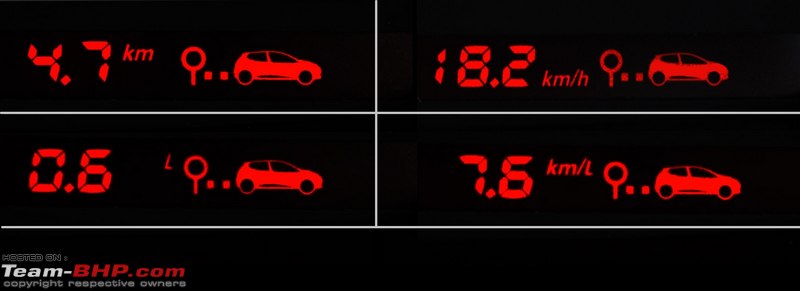 This is the reset button:  All-grey doorpads:  Small door armrest. The area around it isn't padded nor does it have a fabric insert like the Alto 800 / Nano:  Door pocket with bottle holder:  The seats are quite supportive (lateral & under-thigh, both). The light grey and red colours break the monotony of the all-grey interior. Wider cabin than the Alto means you won't be elbowing your front passenger as much as in the Maruti: 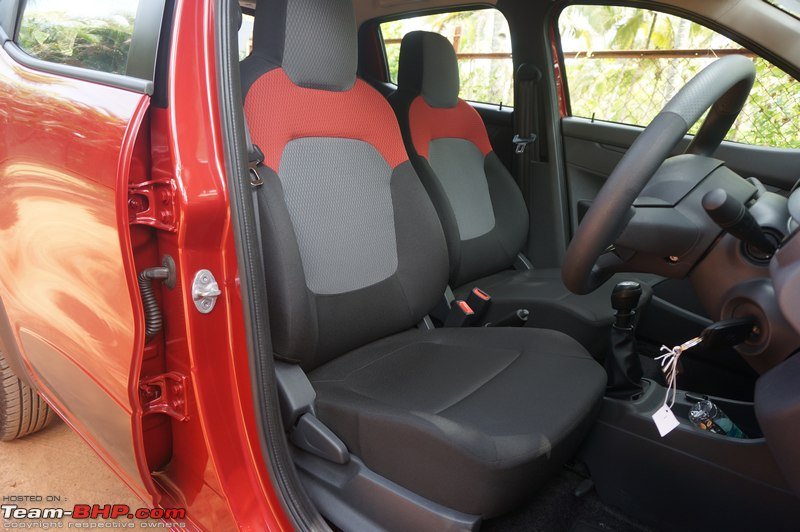 A closer look at the upholstery. Fixed headrests like the other cars in this segment:  Pedals are well-spaced out. No room on the left for a dead pedal or your foot to rest:  The boot & fuel lid levers: 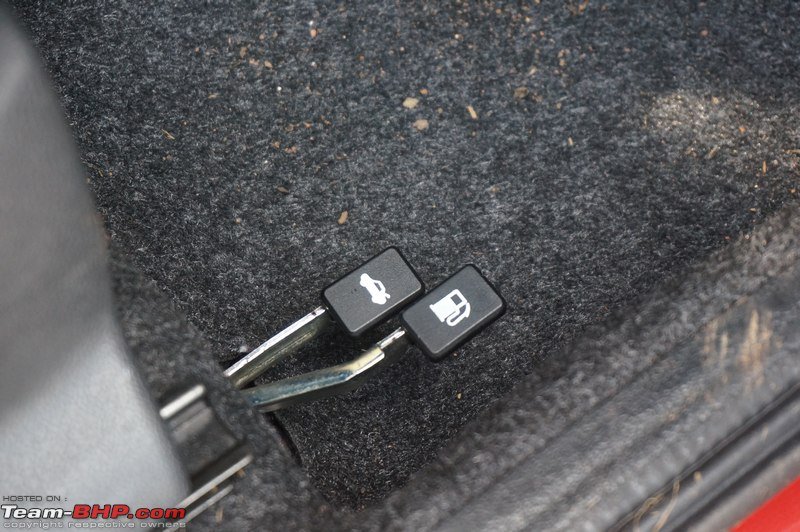 Remote key for the top variant. Unlocking button only works for the doors and not the hatch:  Touchscreen infotainment is one heck of a differentiator! It's covered in a separate post below. Lesser variants get a single-din system. This piano black centre console with a chrome border does add some appeal to the otherwise plain interior. The piano black finish is of a lower grade...looks like the lacquer coat is missing:  Air-con did a fair job of keeping us cool throughout the humid & warm Goa weather. There is no LED light which indicates whether the air-con is on or off:  Hazard light, front power window and central locking buttons are located beneath the air-con controls. Power window controls are unergonomic to use. The doors will only centrally lock / unlock when you press this button. According to rumours (no official confirmation), the round empty space is where you'll see the rotary AMT knob soon:  The gears are easy to slot and throws are of a medium length. However, it isn't precise and has a rubbery nature. You need to pull the ring up the neck for reverse gear:  One of the few cars where you can actually see the bonnet from the driver's seat:  The IRVM is too small:  Visibility from the rear windscreen is poor, with the thick C-pillars making matters worse:  While the ORVMs are sufficiently tall, they should have been wider in size. No internal adjustment. When you want to adjust this one, request your co-passenger or stretch all the way and do it yourself:  A small and medium cupholder ahead of the gear console. There is also a 12V socket to charge your smartphone:  A small cubby area below the handbrake to store loose items. Renault has equipped the handbrake with an audible warning:  The upper glovebox can easily swallow a 1L bottle and some other items:  Even the main glovebox is accommodating:  There is an open storage area between the two:  Basic sunvisors without vanity mirrors or any slot to hold the toll receipts:  Cabin lamp at the front with fade out effect. A more neutral position would have been between the two seat rows. You can also check out the bluetooth mic in this image:  All the air vents can be independently closed. Notice the chrome surround:  The center vents when shut:  2 front speakers are placed on the dashboard. Sound quality is economy-grade:  Basic seatbelts. In this image, check out the pull-type door locks too:  Last edited by GTO : 14th October 2015 at 10:26. |
| |  (46)
Thanks (46)
Thanks
 |
| The following 46 BHPians Thank Vid6639 for this useful post: | .anshuman, aeroamit, Aragorn, ashpalio, beejay, Carpainter, carrazy, chandra1, Chrome6Boy, deetjohn, dr. sen, fusionbang, GTO, Jaggu, JoseVijay, kashif_baig, lancer_rit, mh09ad5578, mi2n, mrbaddy, MSAneesh, nkghai, noopster, pankaj_sachdeva, phynix123, Rajeevraj, RavenAvi, rshanker, RSR, S.MJet, S2!!!, samabhi, SandyX, scopriobharath, SDP, Simhi, sourav9385, suhaas307, SunnyBoi, swiftnfurious, theexperthand, uday.ere, vb-saan, VijayAnand1, vikred, Yeldo |
| | #4 |
| Team-BHP Support  | The 7" Touchscreen ICE 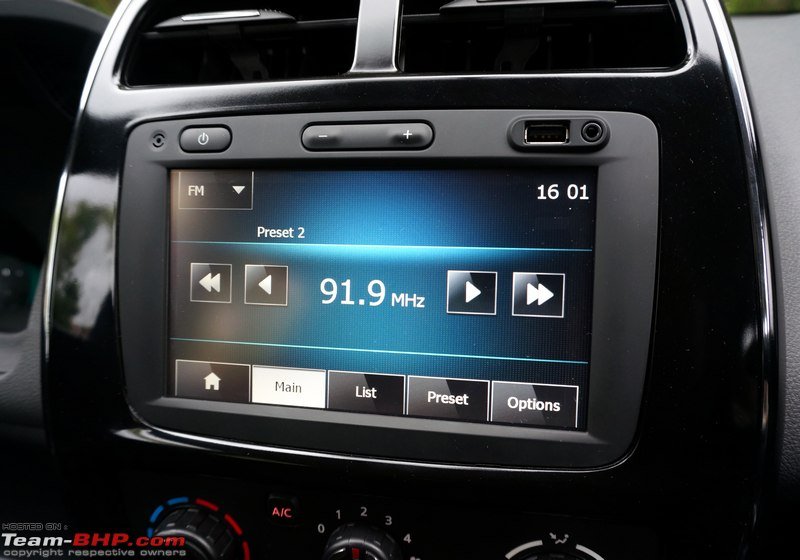 There are 4 variants of the Kwid that get an in-car entertainment system, the RXE (O), RXL, RXT and RXT (O). The RXE (O) & RXL get a basic system with CD, Bluetooth, USB and Aux-in. The top spec RXT & RXT (O) get this 7" touchscreen infotainment system with satellite navigation (no CD player though). This is the same head-unit found in the Lodgy & Duster. Renault is banking on the touchscreen to stand out from the competition. The system is intuitive to operate. It is quite responsive, touch sensitivity is decent and there aren't any bugs like we saw in the early versions of the Honda & Maruti touchscreen systems. What's really a downer is the sound quality from the two 4" dashboard-mounted front speakers. They are simply too weak! What makes matters worse is there are no speaker provisions on the doors or rear parcel shelf of the Kwid. If you buy the Kwid, you'll surely want to start with upgrading the lousy front speakers. Aux, USB & Bluetooth connectivity. No CD or SD card slot though. The Renault-Nissan group sure experiments with their ICE offerings. Datsun gave a smartphone dock in the Go (no head-unit), and here is Renault offering the only touchscreen in the segment: 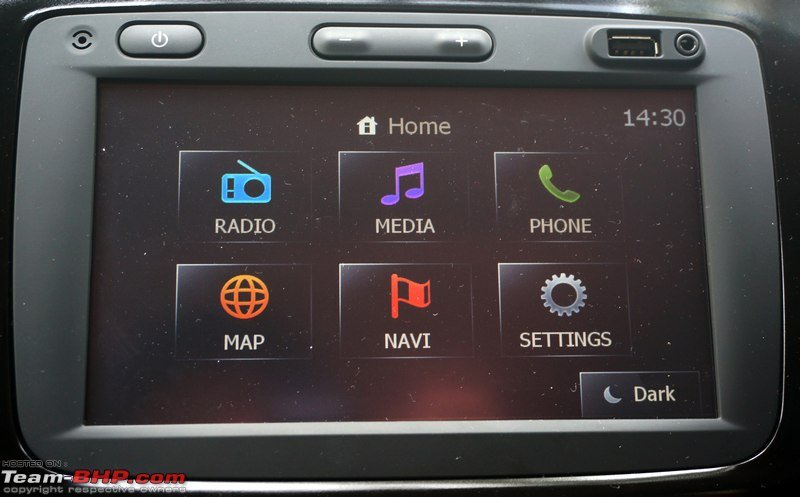 Under the bright sun, the display isn't easy to read. Adjusting the brightness levels didn't help much either:  Sound quality from the weak front speakers is economy grade:  Like most cars with navigation, the Kwid too makes you agree to its terms each time you wish to use the feature:  Maps are provided by Navteq (Nokia):  Satellite navigation:  We found the head-unit pretty intuitive to use. It's made by LG:  Renault gives you 1 year of free map updates:  Nearby points of interest:  You can set a host of alerts...  ...and select the language & gender of the navigator:  Choose between a fast, short or fuel-efficient route:  Last edited by GTO : 14th October 2015 at 10:24. |
| |  (50)
Thanks (50)
Thanks
 |
| The following 50 BHPians Thank Vid6639 for this useful post: | .anshuman, achyu, aeroamit, Aragorn, avingodb, beejay, blackwasp, carrazy, chandra1, Chethan B G, Chrome6Boy, deetjohn, dr. sen, fusionbang, GTO, iliketurtles, InControl, Jaggu, JoseVijay, kannan666, kashif_baig, lancer_rit, mh09ad5578, moralfibre, mrbaddy, nkghai, pankaj_sachdeva, petrolhead_neel, phynix123, RavenAvi, ravradha, rshanker, RSR, S.MJet, S2!!!, samabhi, SandyX, scopriobharath, Simhi, sourav9385, Tamarind, Technocrat, theexperthand, turbospooler, uday.ere, valapad, vb-saan, VijayAnand1, vikred, Yeldo |
| | #5 |
| Team-BHP Support  | Getting in and out of the Kwid’s rear seat isn't an easy affair. The rear doors don’t open wide and the narrow gap between the B-pillar and the seat base hinders ingress / egress. There is also an unusually tall floor lip because of which, passengers will have to lift their feet 3-4” high to get in. Once inside, there’s little to complain about. Space inside is actually comparable to hatchbacks from a segment above (e.g. Celerio), rather than the tiny Alto 800. Neither the Alto nor the Eon allow me to sit behind a 5’8” driver. Surprisingly, even with my 6 ft frame, I was able to sit behind S2!!! (5’10”). Further, after adjusting the driver's seat for myself (albeit in a slightly upright position), S2!!! managed to squeeze behind me as well. The rear bench is flat with no contours. The seat cushioning is on the softer side, but you don’t tend to sink into the seats, thus making it acceptably comfortable. Thanks to the higher seating position, under-thigh support is adequate. Importantly, the seat base has NOT been shortened (like the Alto’s) to portray better legroom. Headroom at the back is enough. Even a person of my height will find the roof a few inches away. On the flip side, the fixed headrests at the back are completely useless for anyone above average height. The rear seat is best suited to 2 adults. A third occupant will be a tight fit. Still, the Kwid's width here is 87 mm more than the Alto 800 and 17 mm more than the Eon. Due to the upward sloping rear window line, no quarter glass, thick C-pillars and dark upholstery, things aren't bright & airy though. Light coming in is limited and some will find it claustrophobic. What I absolutely detested were the non-retractable seatbelts. This meant there were long straps lying all over the rear seat. They’re a pain to use as these need to be untangled, buckled and manually tightened to hold passengers in place. Honestly, this is real lousy stuff from Renault. Another irritant is the belts falling out each time the doors are opened. Unfortunately, rear passengers don’t get any storage spaces - no door pockets, nothing behind the handbrake and no seatback pockets either. The only option is to use the large parcel shelf. Following the segment norm, none of the variants are equipped with rear power windows. You have to manually wind the windows up & down. Rear passengers do get fixed grab handles (front occupants don’t). Pop open the rear hatch and you will be in for a big surprise (pun intended)! The Kwid offers a massive 300 litre boot! To put things in perspective, there’s only one hatchback sold in India that betters the Kwid’s boot capacity - the Honda Jazz at 354 litres. The 300 litre volume is closer to the Dzire (316L) than the Swift (230L). Forget the Alto, it's nowhere close. The Kwid can easily swallow the luggage for an entire family’s weekend trip. To liberate more storage area, the rear seats can fold down f-l-a-t (by removing the seatback), to accommodate 1,115 litres of cargo! In my opinion, the loading lip should have had a plastic cladding to protect the paint from scratches while loading / unloading heavy items. The boot is also the place where you can see Renault skimping on some basics. This is where cost cutting is glaringly obvious. For one, the boot lid feels very light. Unlike the doors, the hatch feels hollow and the sheet metal feels thinner too. Then, there’s the lack of plastic moulding or carpeting to cover the wheel arches. The rear wheel arch metal is completely exposed, as is the strut cap. The rear doors don't open very wide. Ingress / egress isn't easy due to the narrow gap between the seat base and the B-pillar. Manual window winder at the back, as is the segment norm:  Also, you have to lift your feet by 3-4 inches while getting in and out:  Rear legroom is a significant advantage over its competitors. Renault numbers state 116 mm for the Kwid (Eon & Alto = 74 mm): 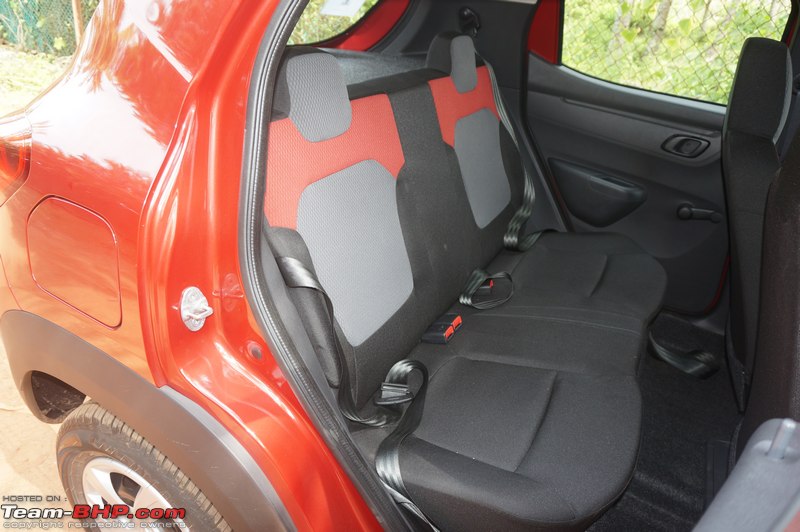 Maximum & minimum legroom shown here:  At 6 ft, I could still sit behind S2!!!'s (5'10") driving position. Sure, there isn't much knee room left, but in this segment, it is impressive. You won't be able to do this in an Alto:  The back seat offers adequate support. Best for two only. The upholstery is on the softer side. Notice the non-retractable seatbelts lying all over the place:  There is space below the front seat to slip your feet in. Additionally, the seat-back is soft and you can bury your knees in it:  Headroom is sufficient even for 6-footer me:  The fixed neck restraints are pointless for anyone over medium height. Non-retractable rear seatbelts are pathetic:  Floor hump is very small:  Front seatbelts are uniquely mounted. Haven't seen this kind of arrangement in any other car:  Fixed grab handles at the rear only:  It's good to see that Renault has given the Kwid a proper headliner:  The glass rolls down ~80% of the way:  Big parcel tray:  300 liter boot! It's the 2nd biggest among Indian hatchbacks (Jazz is no.1):  Lots of room for the family's holiday luggage:  1,115 litres of cargo space & a flat floor with the rear seatback removed (as shown here):  You can also fold the seatback down (instead of removing it). Pull this strap to fold:  With the seatback folded down (not removed): 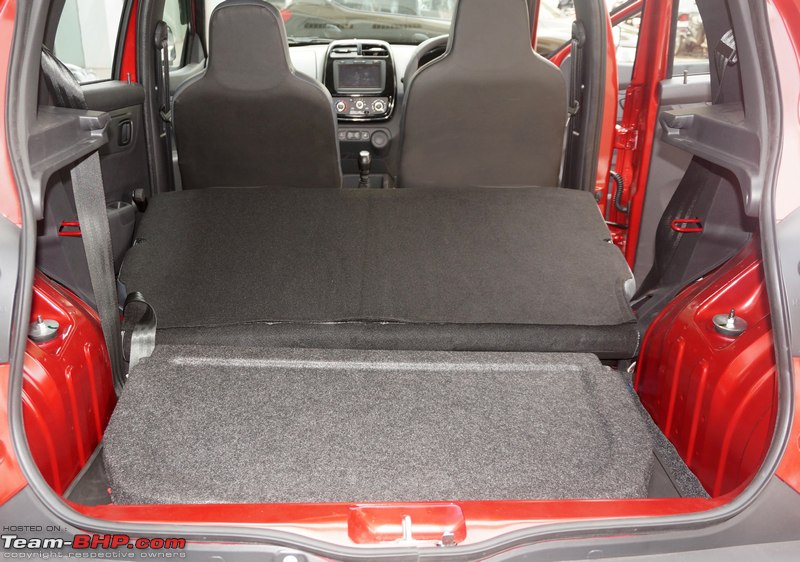 An access panel on the super-light hatch:  There isn't any carpeting here. The visible bare metal along with the strut cover looks ugly. What's worse, BHPians have reported this black cap isn't seen on the dealer demo cars!  Full-size spare wheel:  Notice the loose number-plate light wire that has been taped to the floor. Looks awful!  Last edited by GTO : 15th October 2015 at 16:01. |
| |  (47)
Thanks (47)
Thanks
 |
| The following 47 BHPians Thank Vid6639 for this useful post: | .anshuman, achyu, aeroamit, Aragorn, ashpalio, beejay, carrazy, chandra1, Chethan B G, Chrome6Boy, deetjohn, dr. sen, fusionbang, grevvity, GTO, Jaggu, john doe, JoseVijay, kannan666, kashif_baig, lancer_rit, mh09ad5578, mi2n, moralfibre, mrbaddy, nkghai, pankaj_sachdeva, phynix123, RavenAvi, rshanker, RSR, S.MJet, S2!!!, samabhi, SandyX, scopriobharath, SDP, Simhi, sourav9385, suhaas307, swiftnfurious, theexperthand, uday.ere, vaasu, vb-saan, VijayAnand1, Yeldo |
| | #6 |
| Team-BHP Support  | The engine uses a high percentage of plastic parts. The entire valve cover (not to be mistaken with the head), oil sump and intake manifold are made of plastic. The motor also uses a timing chain that is maintenance-free (rather than a belt). There's a lot of space here and the bay could easily accommodate a bigger engine:  Renault have developed an all-new 0.8L engine to power the Kwid, rather than using the existing 1.2L petrol that powers the Datsun Go & Nissan Micra. A 1.2L would be more expensive to manufacture and it wouldn't be as fuel-efficient either. Such 3-cylinders are inherently more fuel efficient. I had people coming up to me inquiring about the Kwid - the most common question was “Kitna deti hai?” and whether or not it was more than the Alto. Plus, using a smaller engine helps to differentiate its more expensive siblings. That's one of the reasons that Hyundai had launched the Eon with a 0.8L petrol too. This 3-cylinder, 799 cc all-aluminium engine (codenamed BR-8) has 4 valves per cylinder with a double overhead camshaft (DOHC). The power and torque figures of 53 BHP (@ 5,678 rpm) and 72 Nm (@ 4,386 rpm) are par for the segment. Bring in the light kerb weight and you're looking at a power to weight ratio of 80 - 84 BHP ton across the variants. In comparison, the Alto 800 has a power to weight ratio of 68 BHP / ton, while it's 77 BHP / ton for the Eon 0.8L. Of course, let's not forget that the Eon & Alto are both available with more powerful 1.0L engines as well. Start the engine or switch it off and there is a certain amount of cabin shake. Without the air-con, it settles into a refined idle, devoid of vibrations. Turn on the air-con and it's a different animal. Whenever the compressor kicks in, the entire car vibrates, from the doors to the front seats to the steering wheel. With the doors open, you can literally see the entire door shaking. The idle is very lumpy. Of course, these vibrations go away when you increase the revs a little bit or when driving around. An easy solution from Renault would be to increase the idling rpm a little bit. Other than this fly in the ointment, refinement levels are acceptable. On the outside, engine sound is audible and it sounds like a diesel. Once you’re inside and the doors are shut, sound levels are acceptable. The small petrol is clearly tuned for city driveability. Initial accelerator response is instantaneous! Release the clutch from a standstill and, with just a small dab on the super-light throttle, the Kwid lunges forward. At first, the accelerator pedal appears disconnected. It is that light to use! You need to be very gentle with throttle input. The sharp throttle response coupled with the lightweight feel of the pedal actually takes time to get used to. You end up pressing the pedal a little hard (unintentionally) and then, immediately let go of the throttle as the car moves ahead in excitement. This is especially true in bumper to bumper traffic and makes the Kwid jerky. Even as a passenger, S2!!! could feel the jumpiness. However, there is no annoying jerk felt when you lift off the a-pedal. In my older Alto (F8D), this was the biggest gripe I had (the issue was addressed in the updated Alto 800 to an extent, but not entirely). In-city driveability is good. You can upshift early and stay in a higher gear. In fact, you can shift to third at 20 km/h and the Kwid will comfortably chug along all day like an automatic. It felt best at city speeds up to 80 km/h; beyond that, progress is slow and you need to start wringing the engine + gearbox to get anywhere quickly. The best way to drive it is to upshift early and drive in cruise mode. The Kwid will even allow you to commute at 50 km/h in 5th gear without any vibrations. It makes do without a tachometer, but has a useful gearshift indicator that tells you whether to upshift / downshift via an up / down arrow on the tiny MID display. This feature will come in handy for newbie drivers. Expectedly, the indicator is set for efficiency and suggests an upshift as early as possible. We drove the Kwid over some open stretches as well as a hilly section with twisties. Outright acceleration is satisfactory and you can quickly accelerate to 80-90 km/h without a fuss. It doesn't feel underpowered at all up to 90 km/h. Beyond that, power tapers off (as expected of a 0.8 liter engine). Second gear maxes out at 77 km/h. Because there’s no tacho provided, you won’t know when to upshift till you hit the redline. Unlike the Alto 800, there's no sudden fuel cut-off (feeling of hitting a wall) once you reach the redline. Due to its light construction and skinny 155 section tyres, you will get wheel spin when upshifting to second aggressively. There’s no real fun to be had if you push this motor though. The engine is clearly tuned for low-speed driveability and fuel efficiency. The power band is narrow and - after the initial surge of power - there’s not much the engine offers in the higher rpm range. Because of the small size & narrow power band, I really had to work the gearbox in the hilly sections, frequently shifting between 2nd & 3rd. For some situations, 3rd was too tall and in 2nd, the engine would feel too strained. Similarly, when out on the open road, you have to downshift to 4th if the road inclines...and then get back to 5th. The 5th gear is tall and clearly targeted at fuel efficiency which means you have to downshift to 4th every time you lose momentum (even at 80-90 km/h) to get back to speed. On the highway, it's best to drive the Kwid in a relaxed manner. Like other 0.8L cars, the air-con has an effect on engine power. There's a noticeable difference between driving with the air-con on & off. And yes, climbing up an incline, you will have to work the li'l engine in 1st gear. Renault have tuned this engine to maximize economy. The ARAI rating is 25.17 km/l; the Nano (23.6 km/l), Alto 800 (22.74 km/l) and Eon (21.1 km/l) are behind. With its light kerb weight & small 3-cylinder engine, the Kwid will deliver consistently good mileage figures. The Kwid has a light clutch, although the pedal has a longer travel range than expected in a small car. The gears are easy to slot with medium-length throws. There is a hint of a rubbery feeling, yet it is sure-slotting and you won’t miss a shift. Unlike the early Eon, the gear lever doesn't dance about when idling. With throttle inputs, you can feel it move back and forth though. To engage reverse, you have to lift the safety ring and move the lever above 1st. In the area of NVH, as mentioned earlier, vibrations at idle with the air-con on are poor. Renault must increase the idling rpm, even if it is at the cost of fuel-economy. On the move, refinement levels are acceptable at regular rpms. At high revvs, that typical 3-cylinder thrum & harshness are evident. The engine sounds very unpleasant here. It's best to upshift early as this motor is anyway about low-end power delivery. I must add that, at high revs, it’s not as bad as the Alto 800 or the Eon (more like the Alto K10). This is probably due to the engine breathing better, courtesy of the 4 valves per cylinder and DOHC arrangement. You do get some wind noise above 80 km/h from the A-pillar area, but it's not prominent. Road noise is decently controlled for a cheap hatchback, thanks to the insulation in the wheel wells. The Duster and Fluence set the benchmark when it came to ride quality in their respective segments. Renault has carried this trait forward with the Kwid as well. There is a distinct soft edge to the ride, and the suspension irons out all imperfections thrown at it with a muted thud. Only the really large craters result in an unpleasant thud and that’s if you intentionally don’t slow down and aim for them (as we did). Even some unmarked speed breakers which we “missed” were dismissed off comfortably. You could say that the Kwid is rough road-friendly. While this results in very good ride quality at slow speeds, the Kwid doesn't feel as planted at higher speeds. Blame its small size & wheelbase, lightweight construction & soft suspension, but you just don’t get much confidence at triple digit speeds. There is an unpleasant vertical movement over undulating surfaces. Not much different from the other entry-level hatchbacks here. The Kwid is fairly sorted in the area of handling too. Since the suspension is jacked up and towards the softer side, body roll is present, but it's never alarming. When thrown into a series of corners, the Kwid doesn't give up its line easily and grips well. As long as you respect its limits, the Kwid can reward you with its fun to drive trait. There is understeer as you approach the limit but in general, grip levels are good considering the Kwid rides on skinny 155/80 R13 tyres. Its on-road behaviour is much superior to the likes of the Alto. With a tyre upsize to 165 or even 175, that should improve further. What lets it down though is the steering feel on the highway. In the city, drivers will love the fact that you can twirl the wheel with one hand easily. It's very light at low speeds. Combine that with the low-end driveability & taller seating position and the Kwid can be a great city car. The problem is once you pick up speeds - it doesn’t weigh-in enough to inspire confidence. The EPS remains light and vague. At speed, you have to make corrections continuously to maintain the intended line. Even with corrections, I ended up missing a few apexes of corners as I just couldn’t get the wheels to be where I wanted them every time. The steering also has a weak return to centre action and you need to re-centre it yourself while making U-turns. With 180 mm of ground clearance and this wheelbase length, the Kwid won't be scraping its underbelly on bad roads or speed-breakers. On the flip side, its turning radius of 5 meters is much bigger than competitors like the Alto 800 (4.6m) and Eon (4.55m). 5 meters is unusual for such a small car - expect more 3-point turns in tight lanes which the Alto & Eon would handle without a fuss. No variant of the Kwid comes with ABS which is a disappointing norm of this segment. At least the top spec RXT (O) should have been equipped with ABS. Just like driver airbags are making their way to entry-level hatchbacks, ABS will soon. The Kwid's braking is standard fare. It stops in a straight line with no drama. Like other economy hatchbacks, the brakes are more suited to an easy driving style. Hard braking will result in the front wheels locking up as we found out when we had to make an emergency stop. Our particular test car developed a problem with the brakes after a couple of hard braking instances. The brakes started squealing at slow speeds as if something was stuck in between. Hopefully, nothing was broken and it was a one-off issue. We pointed this out to Renault. 799 cc, 3-cylinder 12V DOHC petrol engine which produces 53 BHP & 72 Nm of torque:  For weight reduction, Renault have extensively used plastic parts and reduced the number of clips. What you see here is the plastic valve cover and plastic intake manifold:  Check out the tiny ECU mounted right beside the battery:  Loose windscreen washer tube looks like an eyesore. Don't miss the completely naked wiper console in this picture:  Firewall gets some damping material:  Not many petrols get under-bonnet insulation, but this economy car does. Still, the engine sounds loud & diesel-like from the outside. Bonnet feels heavier than the feather-light tail gate:  The oil pan is made of plastic! The grid design should deflect small stones. Sure, it is >180 mm above the ground, but we were still worried about damage when we drove over some stones on the road. Plastic isn't as strong as metal:  Very basic rear suspension layout. Rather unconventionally, the exhaust end can is next to the fuel tank below the rear seat:  Wheel wells have a rubber coating for insulation. Thus, road noise is well-controlled inside the cabin. Notice the fuel lines (right + rear wheel well) connecting the mouth to the fuel tank:  The inner walls of the fuel lid are painted too. Notice the strap to hold the cap. The fuel tank is relatively small at 28 liters (Alto 800 = 35 liters):  Last edited by GTO : 14th October 2015 at 10:23. |
| |  (50)
Thanks (50)
Thanks
 |
| The following 50 BHPians Thank Vid6639 for this useful post: | .anshuman, 9thsphinx, achyu, aeroamit, anilntny, Aragorn, ashpalio, beejay, carrazy, chandra1, Chethan B G, Chrome6Boy, cowboy45, deetjohn, dr. sen, fiat_tarun, fusionbang, GTO, InControl, isandy, Jaggu, JoseVijay, kannan666, kashif_baig, lancer_rit, mh09ad5578, mrbaddy, MSAneesh, navin, NiInJa, nkghai, Rajeevraj, RavenAvi, RoadSurfer, rshanker, RSR, S.MJet, S2!!!, samabhi, SandyX, scopriobharath, SDP, Simhi, sourav9385, sri2012, thatsdileep, theexperthand, uday.ere, VijayAnand1, Yeldo |
| | #7 |
| Team-BHP Support  | Other Points: • For those customers who like the car and aren't on a strict budget, we hope that Renault offers a larger 1.0 engine in the future...like the Alto K10 & Eon 1.0. A 1.0 makes a big difference (vis a vis a 0.8L) to on-road performance. • The Kwid will be available in 5 colours - Fiery Red, Ice Cool White, Moonlight Silver, Outback Bronze and Planet Grey. The metallic colours are priced Rs. 3,500 higher than the non-metallic colours. • Renault is offering a host of official accessories for the Kwid. The company also has 6 combo packages - Smart Chrome, Intense Chrome, Luxury Pack, Outdoor Pack, Basic Pack and Essential Pack. There are many body vinyl designs too. (link) • Because the wheels have 3 lug nuts, after-market options will be limited. You're better off with whatever alloy wheels Renault offers. • With such a competent small car from Renault, where does that leave the Go & the Datsun brand? We've always disagreed with the idea of a 3rd brand from the Renault-Nissan combine. Datsun was supposed to be the 'cheap' brand and Renault the 'premium'. Renault now goes on to launch a car at a lower price than Datsun! • After the 1st service (2,000 kms / 2 months), the service interval is 10,000 kms / 1 year. Initial 3 services are free. • Even after the key is removed from the ignition slot, the cabin lamp and MID operate for a few minutes and then go off. They turn back on again, once you put the key in the ignition slot or open the door. • The audio system works even without the key in the ignition slot. Yes, it does turn off when you remove the key from the ignition at the end of your drive. However, what's different is that you can start it manually again - right after that. It's rare to see this and can be a bane or boon (depending on how you look at it). • The pull-type door lock knob on the driver’s door works for that door only. For all doors to lock / unlock centrally, you need to use the button on the centre console. • Kwid gets a 2 year / 50,000 kms standard warranty. Renault has also thrown in 2 years of roadside assistance (with towing). Extendable to 4 years / 80,000 kms. • 2 year corrosion protection is standard. Remember this news? • 1 year of free map updates with the sat-nav system. Updates are chargeable from the second year onwards. • Fuel tank capacity is only 28 liters. The Alto has a 35L tank whereas the Eon gets 32L. An audible beep as well as blinking lights on the instrument console warn you when the fuel level is low. • Renault did not mention much about the AMT version even when prodded. We already know that the unit will be from ZF Sachs and is expected to make its way to the Kwid in the months to come. • It has been confirmed that the Kwid will not be available with a diesel. It was never designed to be powered by an oil-burner. The Kwid *might* get alternative fuel versions like CNG or LPG based on demand. • International versions of the Kwid meant for markets like South America will get dual airbags and ABS!! If there is demand, Renault might add these to the Indian version as well. Hopefully, this happens sooner rather than later. Right now, their primary focus is to penetrate the market with killer pricing, to take on the Alto 800. • Nissan will be introducing the Redi-Go in 2016 under the Datsun brand. The concept was shown at the 2014 Auto Expo (link). The Redi-Go, like the Kwid, will be based on the CMF-A platform. • Renault-Nissan's Oragadam (Chennai) factory has a capacity of 4.8 lakh cars / year. • The company claims that 2.9 million viewers logged into the Kwid's webcast when it was unveiled in May 2015 at Chennai. • When it comes to spare parts, Renault guarantees that they will undercut the Alto’s spares by double digits. Challenging, and we hope that's true. God bless competition - it only makes things better for us car owners. • To achieve volumes, you need more dealers. By the end of this year, there will be 205 showrooms across India. Another 75 will be added in 2016. Its current strength is ~164 sales & service centres. • Renault have launched an android mobile app for the Kwid (click here to download). Not only does it give you all the information about the car, competitors etc., but it also lets users book the Kwid for a sum of Rs. 5,000. • Renault has introduced the concept of a virtual showroom. One has to register with his e-mail id, mobile number and select the preferred date & time slot for the experience. Once confirmed, a sales rep will virtually walk you through the car over a LIVE video session. You can ask questions and have an interactive session with the rep. Here's a lighter take on the virtual showroom  - link. - link.Disclaimer: Renault invited Team-BHP for the Kwid test-drive. They covered all the travel expenses for this driving event. Last edited by GTO : 14th October 2015 at 17:51. |
| |  (43)
Thanks (43)
Thanks
 |
| The following 43 BHPians Thank Vid6639 for this useful post: | .anshuman, 9thsphinx, achyu, aeroamit, beejay, blackwasp, carrazy, chandra1, Chethan B G, djay434, dr. sen, fusionbang, GTO, InControl, Jaggu, JoseVijay, kannan666, kashif_baig, lancer_rit, mh09ad5578, mrbaddy, MSAneesh, navin, nkghai, Rajeevraj, RavenAvi, rshanker, RSR, S.MJet, S2!!!, samabhi, Sanzen, scopriobharath, SDP, Simhi, sourav9385, The Rationalist, theexperthand, vb-saan, vgsr, VijayAnand1, Viju, Yeldo |
| | #8 |
| Team-BHP Support  | The Smaller yet Significant Things: Wheel well gap - especially at the rear - is huge:  A net-like cover to prevent unwanted stuff from entering the engine bay. The wiper console area is completely naked!  Only a single reversing light here:  Panel gaps are mostly consistent:  Look closely and you can see the plastic bumper texture through the paint. As a result, the bumpers appear to be of a matte finish while the body is glossy:  Felt lining on the doors:  The B-pillar has plastic cladding all the way up, but the area behind the seatbelt doesn't; the seatbelt covers it up and you won't notice it unless you go looking for it:  Touches of chrome around the instrument console:  Newbie drivers will appreciate the gearshift indicator. It is small though: 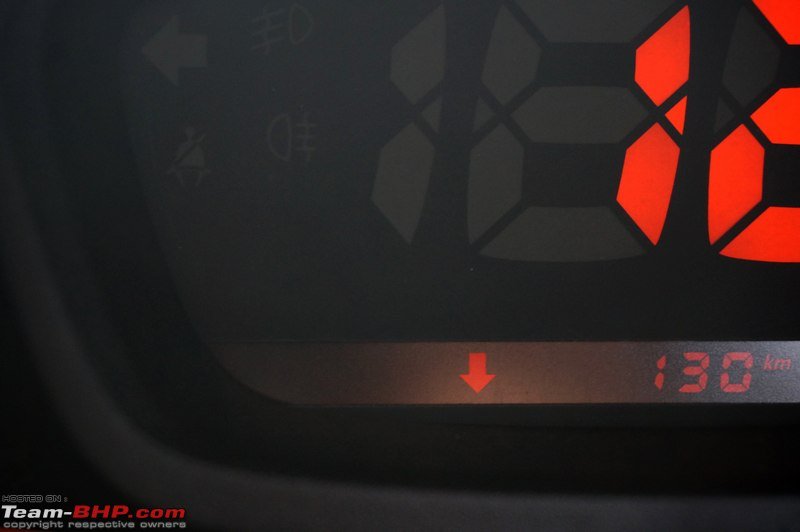 OBD port is hidden away underneath the glovebox: 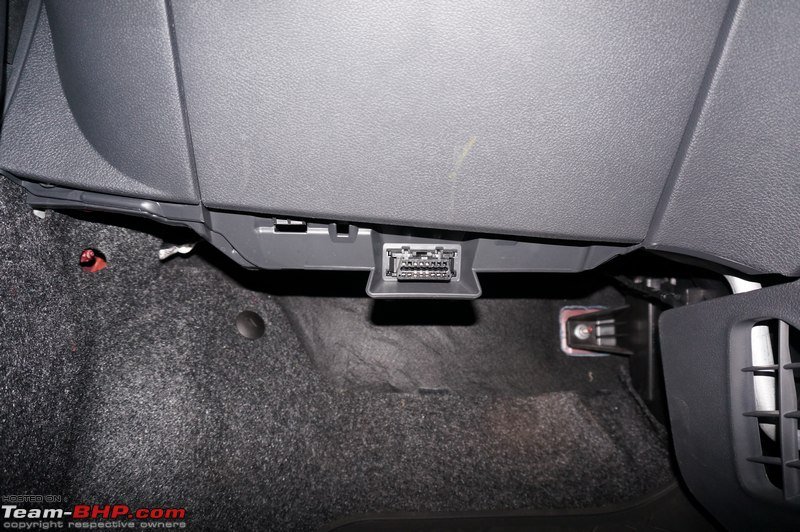 Outdated headlamp leveling knob & bonnet opener belong to the 80's. Even the mechanism of the headlamp leveler is very basic. It's like a cycle brake! Turning the knob results in a metal wire pushing the headlight up or down. You can actually see how it works if you open the hood:  You can literally see the headlamp's adjuster working:  Floor mats are locked into place with these pins:  Like other cars of this segment, there is a small lever for the front seat's fore-aft adjustment. It has a very healthy range:  26.3 liters of in-cabin storage space:  Renault is offering a host of accessories as well as accessory packs (link):  Their chrome package might just become the top-selling accessory  : :  Fake skid plate available as an add-on. Looks nice:  Matte black roof vinyl  : : Roof rails are purely cosmetic in nature:   Chrome gear lever base too:  Mud flaps:  Better speakers? We sure hope so:  Lots of seat covers to choose from:  And a child seat as well!  Thanks to BHPian Chandra1 for sharing this accessory price list:  Last edited by GTO : 14th October 2015 at 10:50. |
| |  (48)
Thanks (48)
Thanks
 |
| The following 48 BHPians Thank Vid6639 for this useful post: | .anshuman, 9thsphinx, achyu, aeroamit, Aragorn, ashpalio, beejay, carrazy, chandra1, Chrome6Boy, deetjohn, dr. sen, Dr.Naren, fiat_tarun, fusionbang, gearedup, GTO, heavenlybull, InControl, Jaggu, kannan666, kashif_baig, lancer_rit, mh09ad5578, mrbaddy, navin, nkghai, Rajeevraj, RavenAvi, rshanker, RSR, S.MJet, S2!!!, samabhi, SandyX, scopriobharath, SDP, Simhi, sourav9385, suhaas307, Tamarind, The Rationalist, theexperthand, uday.ere, vb-saan, vgsr, VijayAnand1, Zahoor23 |
| | #9 |
| Team-BHP Support  | What you’ll like: • A much improved Alto at the same price point • F8D engine has excellent driveability & fuel economy. Neat gearshift too • Comfortable ride quality. Soft suspension is absorbent • Convenient city car: Light, agile & easy to drive • Effective air-conditioner • Driver-side airbag & factory fitted CNG kit available • Maruti's excellent after-sales service & fuss free ownership experience What you won’t: • Cramped rear bench. Also, the seatback is very short • Thin, budget seats offer basic levels of support • Poor outright performance. Mediocre expressway handling. Best driven <100 kph • Puny 145 mm tyres. An upgrade is highly recommended • Lacks the design appeal of the Hyundai Eon • Fared poorly in recent crash tests What you’ll like: • Great looking, modern design for 3 lakhs. Makes other budget cars look outdated • Best-in-class interior quality, fit & finish. Excellent air-conditioner too • Many segment first features (tilt steering, gear indicator etc.) • Frugal 3-cylinder petrol engine delivers high fuel efficiency • Big 215 liter boot has a practical layout • Hyundai's excellent after-sales service What you won’t: • Overall NVH is unimpressive • Pricing is too close to other 4-cylinder hatchbacks (including the i10). Top variants overpriced @ Rs. 4 lakh+ • 0.8L engine doesn't really impress in any particular area • Steering is too light & sensitive at highway speeds • Hyundai's service costs are usually higher than that of the competition Datsun Go 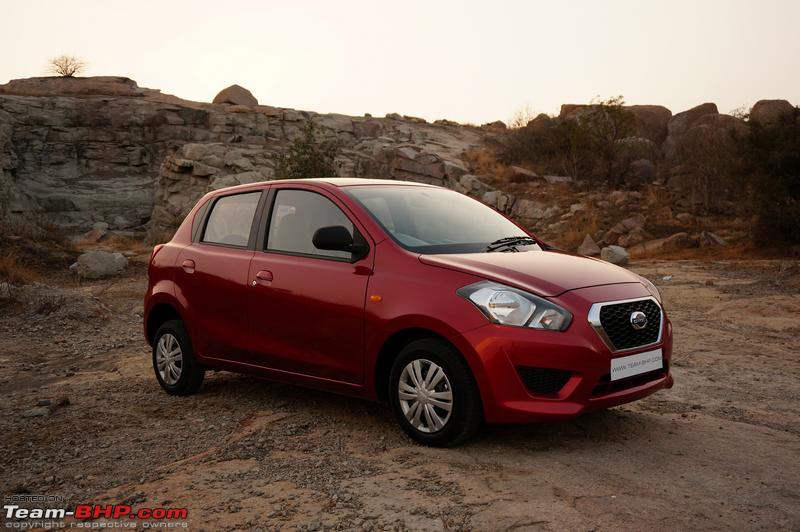 What you'll like: • Clean, inoffensive styling that will please all & offend none • The Go is a size bigger than its direct competitors. Evident on the inside & outside • 1.2L engine results in the segment best torque-to-weight ratio • Urban ride quality is superior to most other entry level hatchbacks • Light driving controls & small turning radius make it well suited as a city car • Large 265 liter boot is very accommodating • Features such as follow me home headlamps, full MID & speed-sensitive wipers What you won't: • Cost cutting is obvious, especially with the interiors • Too noisy. Overall NVH levels are rather poor • Datsun is an unknown brand & Nissan's after-sales service is substandard • Fared poorly in recent crash tests • Awful 155 mm Strada brand tyres • The Micra Active is close, especially from an EMI perspective • Missing essentials (glovebox lid, retractable rear seatbelts, ORVM adjustment stalk, day/night IRVM, proper head-unit) What you'll like: • Cute & cool styling. A car that will make you smile • AMT, light power steering & small footprint make it effortless to drive in the city • Innovative packaging results in spacious interiors for 4 adults. Generous legroom & headroom • Openable tail-gate & bigger fuel tank make the Nano more practical to live with • Powerful air-conditioner will chill you to the bone • Features such as the Bluetooth-stereo, full MID, Zest steering wheel, twin gloveboxes etc. • 4 year warranty is standard (limited to 60,000 kms) What you won't: • Struggles on steep inclines. Unsuitable for highway runs • Drum brakes at the front (no discs) • Basic, bumpy ride quality • Low cost nature & quality. Cheap car image is a deterrent for many • Tiny 94-110 liter boot • Niggles & issues as reported by existing Nano owners • Tata's sub-par after sales service isn't a match to Maruti's What you'll like: • A much improved Alto K10 at the same price point • Power-to-weight ratio of 91 BHP/ton makes this one peppy li'l hatchback • More fuel-efficient than before. AMT variant is also an easy sipper @ 24.07 km/l • Compliant low speed ride quality. Soft suspension is absorbent • Convenient city car: Light, agile & easy to drive (especially the AMT variant) • Driver-side airbag & factory fitted CNG kit available • Maruti's excellent after-sales service & fuss free ownership experience What you won't: • Cramped rear bench. Also, the seatback is very short • Sensitive steering & nervous handling at speed. Best driven <100 kph • VXI (O) trim & airbag unavailable with the AMT. No ABS on any variant • Questionable structural strength. The car which it's based on (Alto 800) fared poorly in crash tests • Skinny 155 mm tyres beg for an upgrade • Flimsy build & economy grade quality. Poor NVH levels as well • More accomplished WagonR & Celerio are priced not too far away Last edited by GTO : 14th October 2015 at 10:20. |
| |  (59)
Thanks (59)
Thanks
 |
| The following 59 BHPians Thank Vid6639 for this useful post: | .anshuman, 9thsphinx, achyu, aeroamit, ampere, arunphilip, arun_kun, Ashir, ashpalio, asingh1977, bblost, beejay, CarCynic, carrazy, chandra1, dr. sen, Dr.Naren, drhoneycake, GhostRider28, Gosu, GTO, Guna, hifisharu, hiren.mistry, InControl, Jaggu, kashif_baig, maximus., mayankverma, mnvvishwa, mrbaddy, MSAneesh, navin, NirmalK, paddu, petrolhead_neel, PrideRed, RavenAvi, rishie, RSR, S.MJet, S2!!!, samabhi, SandyX, scopriobharath, Simhi, srishiva, Sudeep_Kimster, suhaas307, sumansanketh, The Rationalist, theexperthand, uday.ere, valapad, vb-saan, VeluM, VijayAnand1, Vik0728, zavegur |
| | #10 |
| Team-BHP Support  | Re: Renault Kwid : Official Review Thread moved from the Assembly Line to Official Reviews. Thanks for sharing, Vid6639 & S2!!!. Rating thread a well-deserved 5 stars! |
| |  (3)
Thanks (3)
Thanks
 |
| The following 3 BHPians Thank GTO for this useful post: | RSR, uday.ere, valapad |
| | #11 |
| BHPian Join Date: Jul 2015 Location: Dallas - Texas
Posts: 72
Thanked: 136 Times
| Re: Renault Kwid : Official Review Awesome review, and a very competent product from Renault !! Hopefully the service centers and delivery experience will match the high expectations set by the product. I hope they plan an auto tranny in future on 1.0 L engine, and should be a perfect city car. |
| |  (2)
Thanks (2)
Thanks
 |
| The following 2 BHPians Thank Avenger_123 for this useful post: | GTO, RSR |
| |
| | #12 |
| BHPian Join Date: Mar 2013 Location: Pune
Posts: 387
Thanked: 1,002 Times
| Re: Renault Kwid : Official Review Great review as always! Worth the wait. I am pretty sure somewhere in those 25000 bookings, Maruti, Hyundai and Tata must have booked some to take this vehicle to their teardown areas and understand how the hell did they achieve so much weight saving?! Pricing and looks, coupled with Ranbir Kapoor ads, will keep the showrooms full. Let's see if production and dealerships can keep up the rest of the promise to make it a successful car |
| |  (4)
Thanks (4)
Thanks
 |
| The following 4 BHPians Thank turbospooler for this useful post: | arunphilip, Games Goblin, GTO, RSR |
| | #13 |
| Distinguished - BHPian  | Re: Renault Kwid : Official Review Fantastic review of a possible game-changer! You have covered all aspects of the Kwid and the attention given to the minute details is very laudable, Viddy & S2!!!. Full marks & full 5-stars! The Kwid is definitely a strong contender to take the crown in the A-segment in the days to come. Kudos to Renault India for giving everything an Alto competitor needed, and some more! Yes, cost-cutting is ample and evident but to the mass market, what will matter more is the mini SUV-ish stance, in-cabin space and headroom, that large 7-inch tablet-esque central Head Unit, and a huge boot. Show them these 4 critical aspects of the Kwid, and they will lap up the car happily. I am sure we will be hearing a lot about the Kwid in the monthly sales thread in the days to come. Exposed wires, 3 lug nuts on all wheels, huge wheel wells begging for bigger tyres, a mixer-grinder styled knob for the headlamp adjustment and those useless ORVMs do dampen things a bit, but then this is the budget segment and cost-cutting is a given. At the prices at which the Kwid has entered the market, the car is a beautiful mixture of both good aspects and bad - and the pleasant aspects are in the overwhelming majority here. The Kwid has all it's main bases covered to appeal to the majority of the populace, and that is where the sales numbers come from. All the best to Renault! Here comes the Kwid! Last edited by RavenAvi : 14th October 2015 at 11:27. |
| |  (6)
Thanks (6)
Thanks
 |
| The following 6 BHPians Thank RavenAvi for this useful post: | arunphilip, GTO, k_ajay, pdma, RSR, S2!!! |
| | #14 |
| BHPian Join Date: Nov 2011 Location: Bangalore
Posts: 700
Thanked: 1,941 Times
| Re: Renault Kwid : Official Review Superb review! Is it the location? All photo shoots in Goa looks just picture perfect!!  Amazing effort by Renault, have to give them full marks for truly understanding Indian tastes and giving them what they really like! a mini SUVish compact car!! no wonder this champ has managed to garner 25K booking in just couple of months!! I believe at last, a common man is ready to give a miss to Maruti, now that's a welcome sign! |
| |  (2)
Thanks (2)
Thanks
 |
| The following 2 BHPians Thank vinair for this useful post: | GTO, RSR |
| | #15 |
| BHPian Join Date: Feb 2008 Location: Mysore/Dharwad
Posts: 103
Thanked: 132 Times
| Re: Renault Kwid : Official Review I had been to Renault showroom yesterday with our duster ( for one of my umpteen visits to fix even simple things at the service centre). Happened to see the car in the flesh. Car looks good, probably the best looker in the segment very spacious too.. over all, all ingredients for success are there BUT, it is a very big one, what about the pathetic service of renault Right now even with only Dusters and some Scala/Pulse/Lodgy occasionally , the service centers leave a lot to be desired. Their service is totally incapable of managing the present load, leave alone the load expected if this car sells in even half decent numbers The way they treat a customer who has paid 16-17 lakhs for a Duster is shockingly ridiculous, they literally take a customer for granted, No work is ever completed in one visit.   In renault website they write free pick up & drop of cars for lady customers, which the dealership outright refuse to accept!! Also, they never give a bill for pick up & drop charges!! Also even when the car is taken a second time or third for fixing the complaint, they always insist on pick up & drop charges The less i say about their professionalism & quality of work, the better. Just spend half an hour at any Renault service centre and you will come across multiple people yelling at the service advisors out of sheer frustration. In my exprience, even when i take a humble alto for service, maruti treats the customer like a king. If at all Renault needs to click here, they need to stop this high headed attitude and learn from Maruti / Honad/ Hyundai about customer satisfaction. Hell i have had even much better experience from the dreaded Fiat service centres!! I have decided, for my next purchase, i will buy a well supported inferior product rather than well made product with poor support Have a feeling after the initial hype, the car will fail & status quo will be maintained as even though i believe the product here is superior than competition, eventually customer service & reach of service centre matters Last edited by i_see : 14th October 2015 at 11:55. |
| |  (14)
Thanks (14)
Thanks
 |
| The following 14 BHPians Thank i_see for this useful post: | Aficionados, Bh.P, Crazy_cars_guy, DCEite, doxinboy, grevvity, GTO, hybridpetrol, Kool_Kid, lifebuoy, RavenAvi, RSR, S2!!!, Vitalstatistiks |
 |


